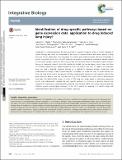| dc.contributor.author | Melas, Ioannis N. | |
| dc.contributor.author | Sakellaropoulos, Theodore | |
| dc.contributor.author | Iorio, Francesco | |
| dc.contributor.author | Alexopoulos, Leonidas G. | |
| dc.contributor.author | Loh, Wei-Yin | |
| dc.contributor.author | Saez-Rodriguez, Julio | |
| dc.contributor.author | Bai, Jane P. F. | |
| dc.contributor.author | Lauffenburger, Douglas A | |
| dc.date.accessioned | 2017-04-05T14:56:32Z | |
| dc.date.available | 2017-04-05T14:56:32Z | |
| dc.date.issued | 2015-05 | |
| dc.date.submitted | 2014-12 | |
| dc.identifier.issn | 1757-9694 | |
| dc.identifier.issn | 1757-9708 | |
| dc.identifier.uri | http://hdl.handle.net/1721.1/107845 | |
| dc.description.abstract | Identification of signaling pathways that are functional in a specific biological context is a major challenge in systems biology, and could be instrumental to the study of complex diseases and various aspects of drug discovery. Recent approaches have attempted to combine gene expression data with prior knowledge of protein connectivity in the form of a PPI network, and employ computational methods to identify subsets of the protein–protein-interaction (PPI) network that are functional, based on the data at hand. However, the use of undirected networks limits the mechanistic insight that can be drawn, since it does not allow for following mechanistically signal transduction from one node to the next. To address this important issue, we used a directed, signaling network as a scaffold to represent protein connectivity, and implemented an Integer Linear Programming (ILP) formulation to model the rules of signal transduction from one node to the next in the network. We then optimized the structure of the network to best fit the gene expression data at hand. We illustrated the utility of ILP modeling with a case study of drug induced lung injury. We identified the modes of action of 200 lung toxic drugs based on their gene expression profiles and, subsequently, merged the drug specific pathways to construct a signaling network that captured the mechanisms underlying Drug Induced Lung Disease (DILD). We further demonstrated the predictive power and biological relevance of the DILD network by applying it to identify drugs with relevant pharmacological mechanisms for treating lung injury. | en_US |
| dc.description.sponsorship | Institute for Collaborative Biotechnologies (Grant W911NF-09-0001) | en_US |
| dc.language.iso | en_US | |
| dc.publisher | Royal Society of Chemistry | en_US |
| dc.relation.isversionof | http://dx.doi.org/10.1039/c4ib00294f | en_US |
| dc.rights | Creative Commons Attribution 4.0 International License | en_US |
| dc.rights.uri | http://creativecommons.org/licenses/by/4.0/ | en_US |
| dc.source | Royal Society of Chemistry | en_US |
| dc.title | Identification of drug-specific pathways based on gene expression data: application to drug induced lung injury | en_US |
| dc.type | Article | en_US |
| dc.identifier.citation | Melas, Ioannis N. et al. “Identification of Drug-Specific Pathways Based on Gene Expression Data: Application to Drug Induced Lung Injury.” Integr. Biol. 7.8 (2015): 904–920. © 2015 The Royal Society of Chemistry | en_US |
| dc.contributor.department | Massachusetts Institute of Technology. Department of Biological Engineering | en_US |
| dc.contributor.mitauthor | Lauffenburger, Douglas A | |
| dc.relation.journal | Integrative Biology | en_US |
| dc.eprint.version | Final published version | en_US |
| dc.type.uri | http://purl.org/eprint/type/JournalArticle | en_US |
| eprint.status | http://purl.org/eprint/status/PeerReviewed | en_US |
| dspace.orderedauthors | Melas, Ioannis N.; Sakellaropoulos, Theodore; Iorio, Francesco; Alexopoulos, Leonidas G.; Loh, Wei-Yin; Lauffenburger, Douglas A.; Saez-Rodriguez, Julio; Bai, Jane P. F. | en_US |
| dspace.embargo.terms | N | en_US |
| mit.license | PUBLISHER_CC | en_US |
| mit.metadata.status | Complete | |
